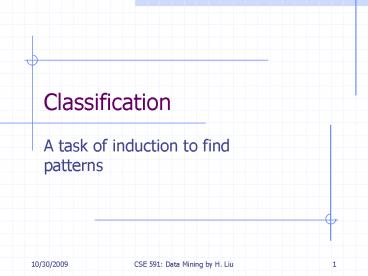Classification - PowerPoint PPT Presentation
Title:
Classification
Description:
Na ve Bayesian classifiers. Support Vector Machines. Ensemble methods. Co-training. and many more ... Na ve Bayes Classifier. This is a direct application ... – PowerPoint PPT presentation
Number of Views:57
Avg rating:3.0/5.0
Title: Classification
1
Classification
- A task of induction to find patterns
2
Outline
- Data and its format
- Problem of Classification
- Learning a classifier
- Different approaches
- Key issues
3
Data and its format
- Data
- attribute-value pairs
- with/without class
- Data type
- continuous/discrete
- nominal
- Data format
- flat
4
Sample data
5
Induction from databases
- Inferring knowledge from data
- The task of deduction
- infer information that is a logical consequence
of querying a database - Who conducted this class before?
- Which courses are attended by Mary?
- Deductive databases extending the RDBMS
6
Classification
- It is one type of induction
- data with class labels
- Examples -
- If weather is rainy then no golf
- If
- If
7
Different approaches
- There exist many techniques
- Decision trees
- Neural networks
- K-nearest neighbors
- Naïve Bayesian classifiers
- Support Vector Machines
- Ensemble methods
- Co-training
- and many more ...
8
A decision tree
9
Inducing a decision tree
- There are many possible trees
- lets try it on the golfing data
- How to find the most compact one
- that is consistent with the data?
- Why the most compact?
- Occams razor principle
- Issue of efficiency w.r.t. optimality
10
Information gain
and
- Entropy -
- Information gain - the difference between the
node before and after splitting
11
Building a compact tree
- The key to building a decision tree - which
attribute to choose in order to branch. - The heuristic is to choose the attribute with the
maximum IG. - Another explanation is to reduce uncertainty as
much as possible.
12
Learn a decision tree
Outlook
sunny
overcast
rain
Humidity
Wind
YES
high
normal
strong
weak
NO
YES
NO
YES
13
K-Nearest Neighbor
- One of the most intuitive classification
algorithm - An unseen instances class is determined by its
nearest neighbor - The problem is it is sensitive to noise
- Instead of using one neighbor, we can use k
neighbors
14
K-NN
- New problems
- lazy learning
- large storage
- An example
- How good is k-NN?
15
Naïve Bayes Classifier
- This is a direct application of Bayes rule
- P(CX) P(XC)P(C)/P(X)
- X - a vector of x1,x2,,xn
- Thats the best classifier you can build
- But, there are problems
16
NBC (2)
- Assume conditional independence between xis
- We have
- An example
- How good is it in reality?
17
Classification via Neural Networks
Squash
?
A perceptron
18
What can a perceptron do?
- Neuron as a computing device
- To separate a linearly separable points
- Nice things about a perceptron
- distributed representation
- local learning
- weight adjusting
19
Linear threshold unit
- Basic concepts projection, thresholding
W vectors evoke 1
W .11 .6
L .7 .7
.5
20
E.g. 1 solution region for AND problem
- Find a weight vector that satisfies all the
constraints
AND problem 0 0 0 0 1 0 1 0 0 1
1 1
21
E.g. 2 Solution region for XOR problem?
XOR problem 0 0 0 0 1 1 1 0 1 1
1 0
22
Learning by error reduction
- Perceptron learning algorithm
- If the activation level of the output unit is 1
when it should be 0, reduce the weight on the
link to the ith input unit by rLi, where Li is
the ith input value and r a learning rate - If the activation level of the output unit is 0
when it should be 1, increase the weight on the
link to the ith input unit by rLi - Otherwise, do nothing
23
Multi-layer perceptrons
- Using the chain rule, we can back-propagate the
errors for a multi-layer perceptrons.
Output layer
Hidden layer
Input layer































